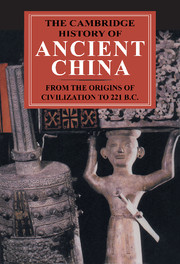Book contents
- Frontmatter
- Introduction
- 1 China on the Eve of the Historical Period
- 2 Language and Writing
- 3 Shang Archaeology
- 4 The Shang: China’s First Historical Dynasty
- 5 Western Zhou History
- 6 Western Zhou Archaeology
- 7 The Waning of the Bronze Age: Material Culture and Social Developments, 770–481 B.C.
- 8 The Spring and Autumn Period
- 9 Warring States Political History
- 10 The Art and Architecture of the Warring States Period
- 11 The Classical Philosophical Writings
- 12 Warring States Natural Philosophy and Occult Thought
- 13 The Northern Frontier in Pre–Imperial China
- 14 The Heritage Left to the Empires
- Bibliography
- Index
- Map 1 Topography of China
- Map 3.1 Archaeological sites of the Early Bronze Age
- Map 6.1 Archaeological sites of the Western Zhou period
- References
8 - The Spring and Autumn Period
Published online by Cambridge University Press: 28 March 2008
- Frontmatter
- Introduction
- 1 China on the Eve of the Historical Period
- 2 Language and Writing
- 3 Shang Archaeology
- 4 The Shang: China’s First Historical Dynasty
- 5 Western Zhou History
- 6 Western Zhou Archaeology
- 7 The Waning of the Bronze Age: Material Culture and Social Developments, 770–481 B.C.
- 8 The Spring and Autumn Period
- 9 Warring States Political History
- 10 The Art and Architecture of the Warring States Period
- 11 The Classical Philosophical Writings
- 12 Warring States Natural Philosophy and Occult Thought
- 13 The Northern Frontier in Pre–Imperial China
- 14 The Heritage Left to the Empires
- Bibliography
- Index
- Map 1 Topography of China
- Map 3.1 Archaeological sites of the Early Bronze Age
- Map 6.1 Archaeological sites of the Western Zhou period
- References
Summary
This chapter is an account of various transformations that took place during the Spring and Autumn period (770–481 B.C.). It covers the transition from a Zhou feudal system to a multistate system; from the expansion of the Zhou into the Yellow River drainage to the ancient China that spanned the Yellow and Yangzi Rivers and the highlands in the north and the west; from an economy based on manorial management to a market economy; and from a family-based society to one based upon great social mobility. The most significant development in this period was a major break through in the intellectual sphere, in which the moral values of Confucius provided an innovative reinterpretation of feudal ethics. This break through brought Chinese culture into a Jaspersian “Axial Age” of civilization. Thereafter, intellectuals served not only as officials in government but, of more profound impact, also as cultural carriers who interpreted the meaning of life and ideals of society. This new condition in the intellectual sphere continued beyond the Spring and Autumn period, remaining characteristic through out Chinese history. In other words, this break through initiated in the Spring and Autumn period would eventually lead China to develop a persistent, collective identity – Chinese civilization.
- Type
- Chapter
- Information
- The Cambridge History of Ancient ChinaFrom the Origins of Civilization to 221 BC, pp. 545 - 586Publisher: Cambridge University PressPrint publication year: 1999
References
- 30
- Cited by

